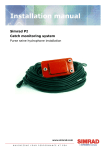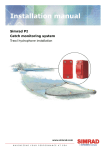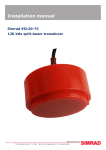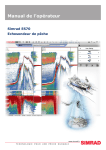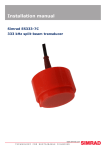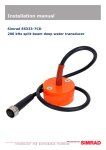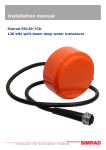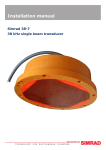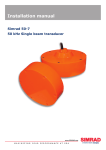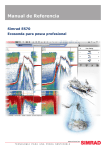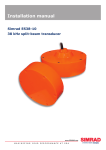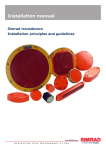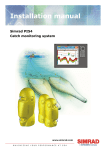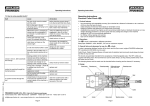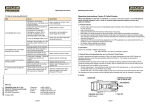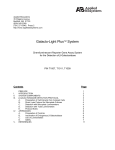Download Simrad ES38-12 - INSTALLATION REV A Installation manual
Transcript
Installation manual Simrad ES38-12 38 kHz split-beam transducer www.simrad.com TECHNOLOGY FOR SUSTAINABLE FISHERIES Simrad ES38-12 Installation manual This document provides a general description of how to install the Simrad ES38-12 Split beam transducer. The information must be regarded as general guidelines and recommendations only. The installation shipyard must design and manufacture installation hardware to fit the ES38-12 transducer on each individual vessel. 344276/A 17.02.2010 © Kongsberg Maritime AS Document history Simrad document number: 344276 / ISBN-13: 978-82-8066-119-7 / Current revision: A Rev.A 15.02 2010 First version. Copyright ©2010 Kongsberg Maritime AS The information contained in this document remains the sole property of Kongsberg Maritime AS. No part of this document may be copied or reproduced in any form or by any means, and the information contained within it is not to be communicated to a third party, without the prior written consent of Kongsberg Maritime AS. The document, or any part of it, may not be translated to any other language without the written approval from Kongsberg Maritime AS. Disclaimer Kongsberg Maritime AS endeavours to ensure that all information in this document is correct and fairly stated, but does not accept liability for any errors or omissions. Warning The equipment to which this manual applies must only be used for the purpose for which it was designed. Improper use or maintenance may cause damage to the equipment and/or injury to personnel. The user must be familiar with the contents of the appropriate manuals before attempting to install, operate or work on the equipment. Kongsberg Maritime AS disclaims any responsibility for damage or injury caused by improper installation, use or maintenance of the equipment. Support information If you require maintenance or repair, contact your local dealer. You can also contact us using the following address: [email protected]. If you need information about our other products, visit our web site. On the web site you will also find a list of our dealers and distributors. Kongsberg Maritime AS www.kongsberg.com Installation manual Table of contents ABOUT THIS MANUAL ....................................................... 5 SIMRAD ES38-12 .............................................................. 6 WHERE TO MOUNT THE TRANSDUCER ............................... 7 HOW TO INSTALL THE TRANSDUCER .............................. 11 Transducer installation in blister ............................................................................ 11 Use a mounting plate whenever provided ..................................................... 11 Smooth surface is important ........................................................................ 11 Example: Large circular transducer.............................................................. 12 Example: Medium and large transducers, principle ....................................... 13 Example: Medium and large transducers, detail ............................................ 13 Common guidelines .................................................................................... 14 Toe-in ........................................................................................................ 14 Physical location......................................................................................... 14 Transducer installation in box keel.........................................................................15 Use mounting plate whenever provided ........................................................ 15 Smooth surface is important ........................................................................ 15 Example: Box keel installation .................................................................... 16 Transducer flush mounted in a steel tank ...............................................................16 Use mounting plate whenever provided ........................................................ 16 Smooth surface is important ........................................................................ 16 Water filled................................................................................................. 16 Example: Flush mounting in a steel tank ...................................................... 17 Transducer with acoustic window ..........................................................................17 Use mounting plate whenever provided ........................................................ 17 Smooth surface is important ........................................................................ 17 Example: Acoustic window......................................................................... 18 Transducer mounted inside the hull .......................................................................18 Use mounting plate whenever provided ........................................................ 18 Smooth surface is important ........................................................................ 18 Example: Mounting inside the hull .............................................................. 19 Transducer mounted on a drop keel .......................................................................19 Retractable transducer ............................................................................................20 TOWED BODY INSTALLATION ......................................... 21 General requirements .............................................................................................21 Smooth surface is important ........................................................................ 21 Use mounting and clamping rings whenever provided ................................... 21 Use a mounting plate whenever provided ..................................................... 21 Installation in a towed body ...................................................................................22 344276/A 3 Simrad ES38-12 Example: Small transducer.......................................................................... 23 Example: Medium and large transducers ...................................................... 23 Example: Dual transducer arrangement ........................................................ 24 STEEL CONDUIT .............................................................. 25 TRANSDUCER HANDLING AND MAINTENANCE ................ 26 Rules for transducer handling.................................................................................26 Rules for transducer maintenance ..........................................................................27 Approved anti-fouling paints for transducers.........................................................28 Using self-locking taps ...........................................................................................28 Introduction to Emuge self-locking threads................................................... 29 Drawing standard........................................................................................ 30 Taps and gauges.......................................................................................... 30 Self-lock taps provided by Simrad ............................................................... 31 Supplier and manufacturer........................................................................... 31 TRANSDUCER CABLE SPLICING....................................... 32 DRAWING FILE ............................................................... 33 Echo sounder connections ......................................................................................33 Splicing the transducer cable ....................................................................... 33 General Purpose Transceiver (GPT) wiring................................................... 34 General Purpose Transceiver (GPT) transducer plug assembly ....................... 35 ES38-12 Outline dimensions and installation drawings.........................................36 Outline dimensions [111337] ....................................................................... 37 Mounting plate [111492] ............................................................................. 38 Installation principles [111495].................................................................... 39 4 344276/A About this manual About this manual Purpose The purpose of this installation manual is to provide the generic descriptions and illustrations that allows you to understand the basic principles for echo sounder transducer installation. About the information provided in this document The information in this document must be regarded as general guidelines and recommendations only. The installation shipyard must design and manufacture installation hardware to fit each individual transducer and vessel. Approval by maritime authorities Whenever required, the installation shipyard must also have the installation approved by the applicable maritime authorities. Additional information For additional detailed information about the transducer to be installed, refer to the documentation provided with the transducer. Drawings and descriptions can also be obtained from http://www.simrad.com. 344276/A 5 Simrad ES38-12 Simrad ES38-12 The purpose of this manual is the provide the basic information required to install the Simrad ES38-12 Split beam transducer. Transducer and documents • Simrad ES38-12: KSV-111497 • Data sheet: 164276 • Drawings: – Outline dimensions: 111337 – Mounting plate: 111492 – Installation principles: 111495 Note Although drawings are provided to explain the installation principles, the installation shipyard must provide the final drawings required to fit the transducer to each individual vessel. Also, when applicable, the installation shipyard must have the drawings and installation approved by the proper maritime authorities. The drawings specific for the ES38-12 transducer are located in the Drawing file on page 33. Technical specifications Refer to the Simrad ES38-12 data sheet. You can read and/or download the data sheet on http://www.simrad.com. Additional parts provided for installation The following items can be supplied by Simrad to facilitate installation. The items must be ordered separately. • Mounting plate: 499–111492 6 344276/A Where to mount the transducer Where to mount the transducer A single answer to the question where to locate the transducer cannot be given. It depends very much on the vessel’s construction, how the hull is shaped and how the water runs along the hull. There are however a number of important guide lines, and some of these are even conflicting. Mount the transducer deep Mount the transducer at a deep position on the hull. Consider the situations when the vessel is unloaded, and when it is pitching in heavy seas. There are several reasons for this. 1 The upper water layers of the sea contain a myriad of small air bubbles created by the breaking waves. In heavy seas the upper 5 to 10 metres may be filled with air, and the highest concentrations will be near the surface. Air bubbles absorb and reflect the sound energy, and they may in worst cases block the sound transmission altogether. 2 Another reason to go deep is the cavitation in front of high power transducers. Cavitation is the formation of small bubbles in the water due to the resulting local pressure becoming negative during parts of the acoustic pressure cycles. The cavitation threshold increases with the hydrostatic pressure. 3 The transducer must never be lifted free of the water surface. Transmitting into open air may damage the transducer beyond repair. Mounting the transducer at a deep position on the hull prevents this. 4 If the transducer is lifted up from the water during heavy seas, it may be damaged when the hull strikes back at the sea surface. This is especially important for low frequency transducers with large faces. Mount the transducer away from protruding objects on the hull Objects protruding from the hull, such as zinc anodes, sonar transducers or even the vessel’s keel, generate turbulence and flow noise. Holes and pipe outlets are also important noise sources. They may act as resonant cavities amplifying the flow noise at certain frequencies. Do not place an echo sounder transducer in the vicinity of such objects, and especially not close behind them. For the same reason, it is very important 344276/A 7 Simrad ES38-12 that the hull area around the transducer face is as smooth and level as possible. Even traces of sealing compound, sharp edges, protruding bolts or bolt holes without filling compound will create noise. Mount the transducer at the forward part of the hull to minimise the effects from the boundary water layer When the vessel forces its way through the sea, the friction between the hull and the water creates a boundary layer. The thickness of the boundary layer depends upon vessel speed and the roughness of the hull. Objects protruding from the hull, and dents in the hull, disturb the flow and increase the thickness of the boundary layer. The flow in this boundary layer may be laminar or turbulent. A laminar flow is a nicely ordered, parallel movement of the water. A turbulent flow has a disorderly pattern, full of eddies. The boundary layer increases in thickness when the flow goes from laminar to turbulent. The figure below illustrates the boundary layer of a vessel moving through the water. Furthermore, air bubbles in the sea water are pressed down below the hull and mixed into the boundary layer. The boundary layer is thin underneath the forward part of the vessel, and increases in thickness as it moves towards aft. If the sides of the hull are steep, some of the air bubbles in the boundary layer may escape to the sea surface along the vessel sides. It is our experience that a wide and flat bottom, with a rising angle less than around 13 degrees, is prone to giving air problems for the transducer. In any case a transducer location in the forward part of the hull is preferred in order to minimise the influence of the boundary layer. Figure 1 Boundary water layer A Turbulent flow B Laminar flow C Air bubbles in the water 8 344276/A Where to mount the transducer Mount the transducer far away from the propellers The propulsion propeller is the dominant noise source on most fishing vessels, research vessels, merchant vessels and pleasure crafts. The noise is transmitted through the sea water. For this reason, the transducer should be placed far away from the propeller, which means on the fore part of the hull. Positions outside the direct line of sight from the propeller are favourable. On small vessels with short distances it is advised to mount the transducer on that side of the keel where the propeller blades move upwards, because the propeller cavitation is strongest on the other side. The cavitation starts most easily when the water flows in the same direction as the propeller blade, and that is to some degree the case at that side of the keel where the propeller blades move downwards. Mount the transducer far away from the bow thrusters Bow thruster propellers are extremely noisy. When in operation, the noise and cavitation bubbles created by the thruster make the echo sounder useless, almost no matter where the transducer is installed. And when not in operation, the tunnel creates turbulence, and if the vessel is pitching, the tunnel may be filled with air or aerated water in the upper position and release this in the lower position. In general, all transducers must be therefore placed well away from the bow thruster. However, this is not an invariable rule. Certain thruster designs combined with its physical location on the hull may still offer suitable transducer locations near the thruster. If you are in doubt, consult a naval architect. Mount the transducer with a slightly inclined transducer face Ideally, the transducer face should be mounted in parallel with the sea surface when the vessel is in normal trim, as this will provide the most accurate echo information. However, it is also very important that the water flow over the transducer face is laminar. In order to ensure laminar flow, the transducer face may be tilted slightly upwards in relation to the water flow. This allows the flowing water to meet the face directly, and assures laminar flow. The inclination angle must however be determined carefully. The angle must be small on transducers with narrow beam angles. As a rule of thumb, mount transducers with beam angles smaller than seven degrees with minimum inclination angle. The smaller beam angle your transducer has, the smaller the inclination angle can be. Ensure that you do not mount the transducer with a negative inclination angle. This may cause turbulence under the transducer face, and reduced echo sounder performance. Summary and general recommendations Some of the above guide lines are conflicting, and each case has to be treated individually in order to find the best compromise. Generally the propeller noise is the dominant factor, and a recommended transducer location is in the fore part of the hull, with maximum distance from the bow equal to one third of the total length of the hull at the water line. 344276/A 9 Simrad ES38-12 Figure 2 General recommendation for transducer location A Transducer B Inclination angle C Hull length at water line D Maximum 1/3 of the hull length at water line (C) If the vessel hull has a bulbous bow, this may well be a good transducer location, but also here must be taken into consideration the flow pattern of the aerated water. Often the foremost part of the bulb is preferable. Figure 3 Recommended location of the transducer on a bulbous hull 10 A Thruster B Transducer location 344276/A How to install the transducer How to install the transducer There are many different ways to mount the transducer. These are the recommended methods to mount a large and medium sized transducer using a mounting plate. Topics • Transducer installation in blister on page 11 • Transducer installation in box keel on page 15 • Transducer flush mounted in a steel tank on page 16 • Transducer with acoustic window on page 17 • Transducer mounted inside the hull on page 18 • Transducer mounted on a drop keel on page 19 • Retractable transducer on page 20 Transducer installation in blister One recommended transducer installation method is by means of a blister. The blister must be designed and manufactured by the installation shipyard to fit both the transducer body, and the vessel’s size and hull shape. Use a mounting plate whenever provided Certain transducers may be provided with a mounting plate, or with drawings to allow for local production of this. The mounting plate is welded to the hole prepared for the transducer. Bolts through the transducer body into the mounting plate will secure the transducer. Smooth surface is important Mounting screws or bolts must not be extruding from the transducer or the area immediately around it. Make sure that the surface of the transducer face, the installation hardware used to mount it, the hull plating and the putty around the transducer is as even and smooth as possible. Obstructions on these surfaces will create problems with turbulent flow. 344276/A 11 Simrad ES38-12 Example: Large circular transducer The illustration below shows a typical transducer blister designed for a large transducer. Note that due to the physical size of the transducer, a U-shaped support bar (E) is used to support the transducer. The purpose of this support is to prevent the transducer from being pushed up into the blister in heavy seas. Figure 4 Large circular transducer A Streamlined blister F Forward B Stiffening rib G Cable service loop C Drainage holes H Stuffing tube D Inclination angle I Minimum 400 mm E U-shaped support bar (recommended on large transducers) J Rounded corners K Air outlet 12 344276/A How to install the transducer Example: Medium and large transducers, principle Figure 5 Medium and large transducers using mounting plate This illustration shows the installation principle of a medium or large transducer using a mounting plate. A Air outlet B Streamlined blister C Transducer cable D Transducer E Mounting plate F Forward Example: Medium and large transducers, detail Figure 6 Installation principle, medium and large transducers A Mounting ring/plate B Hull plating on towed body C Transducer D “Clamping ring” functionality facilitated by transducer body E Bolt This illustration shows the installation principle of a medium or large transducers using a mounting ring or -plate. Note that a clamping ring is not required, as the transducer body is shaped to facilitate this function. 344276/A 13 Simrad ES38-12 Common guidelines The best performance is obtained with a blister height of 40 cm or more. A streamlined shape and rounded edges reduce the flow noise. A vertical leading edge or front will guide the aerated water to the sides of the blister. The orientation of the blister should follow the water flow. The interior of the blister must be filled with sea water. Use drainage holes in the bottom and an air outlet on the top. The water pressure behind the transducer will then compensate for the outside pressure during vessel movements in rough sea. We recommend that large diameter transducers are fitted with a horizontal U-shaped support bar. This bar can then be secured to the mounting ring using threaded rods. The transducer cable penetrates the hull in a stuffing tube. Leave an adequate loop of the cable behind the transducer for easy mounting or removal of the transducer. Toe-in Figure 7 Toe-in principle A Keel B Blister C Toe-in angle The primary consideration must be to allow laminar water flow. In most cases this is achieved by designing the blister in parallel with the keel. However, if the blister is located close to the bow, the front of the blister may have a few degrees toe-in towards the bow. The angle must be chosen to allow for most efficient water flow. It will vary with the location of the transducer; the depth below the hull, the distance from the bow, and the distance to the keel. Typical angles are from 0 to 3° on deplacement hulls. On planing hulls, the angle is normally close to 0°. Physical location The blister is placed on one of the sides of the hull, and the distance from the keel is a trade off between a close distance giving a turbulent flow of water in a narrow passage, and a large distance bringing the transducer higher up and also more affected by vessel roll. Normally a distance of approximately 1 m is a good compromise. 14 344276/A How to install the transducer Figure 8 Physical location of blister A Keel B Transducer blister C Horizontal distance between keel and blister D Vertical distance between the blister surface and the keel Observe the horizontal and vertical distances (C and D) between the keel and the transducer blister. On a medium sized vessel, the horizontal distance (C) should be approximately 1 meter. The vertical distance (D) must in general be as small as possible. This is important to prevent the keel from shadowing the transducer beam in shallow waters. Transducer installation in box keel Vessels with a box keel may use this for transducer installation. The box keel is already the deepest part of the vessel. If the box keel is too narrow to accommodate the transducer, it can be widened, either symmetrically or to one side only. In the last case the installation could also be described as a blister merged into the keel. Use mounting plate whenever provided Certain transducers may be provided with a mounting plate, or with drawings to allow for local production of this. The mounting plate is welded to the hole prepared for the transducer. Bolts through the transducer body into the mounting plate will secure the transducer. Smooth surface is important Mounting screws or bolts must not be extruding from the transducer or the area immediately around it. Make sure that the surface of the transducer face, the installation hardware used to mount it, the hull plating and the putty around the transducer is as even and smooth as possible. Obstructions on these surfaces will create problems with turbulent flow. 344276/A 15 Simrad ES38-12 Example: Box keel installation Figure 9 Box keel installation The figure illustrates a symmetrical box keel installation. A Box keel B U-shaped support bar (only recommended on large transducers) C Stuffing tube D Cable in steel conduit E Cable service loop Transducer flush mounted in a steel tank Flush mounting is used on very large vessels with a hull so deep that no air bubbles are found below the hull, and on vessels operating in shallow harbours or waters, where a protruding blister can not be accepted. The standard procedure for flush mounting on a steel vessel is to weld a steel tank inside the hull, and mount the transducer into this tank. Use mounting plate whenever provided Certain transducers may be provided with a mounting plate, or with drawings to allow for local production of this. The mounting plate is welded to the hole prepared for the transducer. Bolts through the transducer body into the mounting plate will secure the transducer. Smooth surface is important Mounting screws or bolts must not be extruding from the transducer or the area immediately around it. Make sure that the surface of the transducer face, the installation hardware used to mount it, the hull plating and the putty around the transducer is as even and smooth as possible. Obstructions on these surfaces will create problems with turbulent flow. Water filled As for a blister, the interior of the tank must be filled with water. 16 344276/A How to install the transducer This can be accomplished by air release through a steel tube, which is extended either to open air 1.5 m above the water line or to the water outside the hull at a point higher than the tank interior. If the tube is extended to open air, drainage must be provided with leakage at the transducer flange or a separate hole in the tank bottom. Example: Flush mounting in a steel tank Figure 10 Flush mounting in a steel tank A B C D E F G Steel tank Water Drainage hole Cable service loop Steel tube for air outlet Stuffing tube Cable in steel conduit The figure illustrates the installation principles when the transducer is mounted in a steel tank. Transducer with acoustic window Vessels operating in arctic waters need special attention on transducer installation. Floating blocks of ice may damage even a flush mounted transducer face. For this situation Simrad offers arctic tanks in different sizes. Use mounting plate whenever provided Certain transducers may be provided with a mounting plate, or with drawings to allow for local production of this. The mounting plate is welded to the hole prepared for the transducer. Bolts through the transducer body into the mounting plate will secure the transducer. Smooth surface is important Mounting screws or bolts must not be extruding from the transducer or the area immediately around it. Make sure that the surface of the transducer face, the installation hardware used to mount it, the hull plating and the putty around the transducer is as even and smooth as possible. Obstructions on these surfaces will create problems with turbulent flow. 344276/A 17 Simrad ES38-12 Example: Acoustic window Figure 11 Acoustic window A Steel tank B Oil C Acoustic window D Cable service loop E Stuffing tube F Cable in steel conduit G Oil inlet The transducer shown in the figure is mounted inside the tank behind a strong acoustic window. The window is typically made of polycarbonate. The tank is filled with oil. Transducer mounted inside the hull The transducer can also be mounted inside the hull. An installation of the transducer inside the hull, and sounding through the hull, requires a good acoustic contact between the transducer face and the hull. Build a tank around the transducer and fill it with a liquid. Oil used in hydraulic systems is a well suited liquid for this purpose. It contains no gas bubbles and is non-corrosive. Typical values of the two way loss are 3 dB for polyester, 6 dB for aluminium and 10 dB for steel. Hulls made of wood or a sandwich type with foam in the middle, attenuate the sound so much that through hull sounding must be regarded as impossible. The loss varies with the distance between transducer face and the hull. The best result is obtained when the distance is half a wavelength. Consult Simrad for advice. In addition to the loss, the beam pattern is degraded, because a larger area of the hull is set into vibrations. Use mounting plate whenever provided Certain transducers may be provided with a mounting plate, or with drawings to allow for local production of this. The mounting plate is welded to the hole prepared for the transducer. Bolts through the transducer body into the mounting plate will secure the transducer. Smooth surface is important Mounting screws or bolts must not be extruding from the transducer or the area immediately around it. 18 344276/A How to install the transducer Make sure that the surface of the transducer face, the installation hardware used to mount it, the hull plating and the putty around the transducer is as even and smooth as possible. Obstructions on these surfaces will create problems with turbulent flow. Example: Mounting inside the hull Figure 12 Mounting inside the hull A Steel tank B Oil C Hull plating D Cable service loop E Stuffing tube F Cable in steel conduit G Hole for oil filling H Air outlet The transducer shown in the figure is mounted inside the hull. The tank is filled with oil. Transducer mounted on a drop keel The use of a drop keel with the purpose of stabilising the vessel is well known. Figure 13 Drop keel installation A Instrument keel shaft B Lowered position C Bottom view A drop keel is also a superior platform for echo sounder transducers. Such instrument keels have been built, mainly on research vessels, often protruding as far as three meters below the hull. At that depth, the water is free of air bubbles up to very high sea states. The vessel is then able to perform reliable acoustic measurements in open sea a larger part of the year. 344276/A 19 Simrad ES38-12 Retractable transducer Hull units allowing the transducer to be lowered and hoisted are commonly used for horizontal looking sonars. When not in use, the transducer is retracted into a trunk. Figure 14 Retractable transducer A Transducer B Trunk C Transducer shaft D Transducer shaft sleeve E Keel The retractable hull unit is more expensive than a blister, but on vessels with a hull where it is difficult or impossible to install a blister, it may still be worth while. The principles of a hull unit with a retractable transducer is shown below. Vessels without a keel and with a wide, flat bottom is an example where a retractable hull unit can be the only acceptable method for bringing the echo sounder transducer below the boundary layer. 20 344276/A Towed body installation Towed body installation These are the recommended methods to mount transducers in a towed body. Topics • General requirements on page 21 • Installation in a towed body on page 22 General requirements Smooth surface is important Mounting screws or bolts must not be extruding from the transducer or the area immediately around it. Make sure that the surface of the transducer face, the installation hardware used to mount it, the hull plating and the putty around the transducer is as even and smooth as possible. Obstructions on these surfaces will create problems with turbulent flow. Use mounting and clamping rings whenever provided Circular transducers may be provided with mounting and clamping rings, or with drawings to allow for local production of these. The mounting ring is welded to the hole prepared for the transducer, while the clamping ring fits around the edge of the transducer body. Bolts through the clamping ring into the mounting ring will secure the transducer between them. Note that several transducers use direction guides to allow correct mounting. Use a mounting plate whenever provided Certain transducers may be provided with a mounting plate, or with drawings to allow for local production of this. The mounting plate is welded to the hole prepared for the transducer. Bolts through the transducer body into the mounting plate will secure the transducer. 344276/A 21 Simrad ES38-12 Installation in a towed body Transducers designed to withstand large water pressure are provided for use in towed bodies. The recommended installation method is through the hull plating hull using a mounting plate, or with mounting and clamping rings. The installation arrangement on the towed body must be designed by the manufacturer of the towed body to fit its shape and characteristics. 22 344276/A Towed body installation Example: Small transducer Figure 15 Small transducer with mounting and clamping rings A Mounting ring B Hull plating on towed body C Transducer D Clamping ring E Bolt This illustration shows the installation principle of a small circular transducer using clamping and mounting rings. Example: Medium and large transducers Figure 16 Installation principle, medium and large transducers A Mounting ring/plate B Hull plating on towed body C Transducer D “Clamping ring” functionality facilitated by transducer body E Bolt This illustration shows the installation principle of a medium or large transducers using a mounting ring or -plate. Note that a clamping ring is not required, as the transducer body is shaped to facilitate this function. 344276/A 23 Simrad ES38-12 Example: Dual transducer arrangement Figure 17 24 Dual transducer arrangement This illustration shows a typical through the hull installation of small and large circular transducers on a towed body. A Small transducer B Medium or larger transducer C Electronic equipment in watertight compartment 344276/A Steel conduit Steel conduit Why use steel conduits? It is strongly recommended to lay a steel conduit from the transducer’s cable gland to the echo sounder transceiver, and to pull the transducer cable through this conduit. There are several reasons for this. • It will make it easier at a later stage to replace the transducer. • Noise and interference from other electrical equipment is greatly reduced. • The risk of flooding is greatly reduced if the pipe is terminate above the water line. With a steel conduit the installation will satisfy the EU regulations for EMC interference. Without a steel conduit, there is a risk of reduced echo sounder performance. Steel conduits qualities and shielding The steel conduit must be unbroken and watertight from the transducer to above the water line. From there, the cable can be pulled further, or a junction box can be installed to facilitate further connections. Note that the steel conduit must act as a continuous electrical screen all the way. Steel conduit dimensions: • minimum 35 mm inner diameter • minimum 6 mm wall thickness (4.5 mm if galvanised) More that one transducer cable? If two or more transducers are installed close to each other it is possible to pull their cables in the same steel conduit, provided the conduit diameter is increased accordingly. However, for easy replacement it is recommended that each transducer has its own steel conduit. 344276/A 25 Simrad ES38-12 Transducer handling and maintenance You MUST observe the following rules for handling, maintenance and painting. Topics • Rules for transducer handling on page 26 • Rules for transducer maintenance on page 27 • Approved anti-fouling paints for transducers on page 28 • Using self-locking taps on page 28 Rules for transducer handling Note Do not lift the transducer by the cable. Do not expose the transducer to direct sunlight. Do not expose the transducer to excessive heat. Transport protection Some transducers are delivered with a cover plate on the face for protection during transport. Let this plate stay on as long as possible, but do not forget to remove it before the vessel goes into the sea. Painting the transducer face An anti-fouling paint may be applied to the transducer face. Because some paint types may be aggressive to the polyurethane in the transducer face, please consult Simrad’s list of approved paints. See Approved anti-fouling paints for transducers on page 28. 26 344276/A Transducer handling and maintenance Cleaning the transducer face Whenever opportunity arise, for example when the vessel is dry docked, the transducer face may be cleaned for shells and other marine fouling. Be careful not to make cuts in the transducer face. Use a piece of soft wood or a very fine grade emery paper. Special rules for acoustic windows Arctic tanks have acoustic windows made of polycarbonate. These must neither be painted nor cleaned with chemicals. Acoustic windows must not be exposed to direct sunlight. Rules for transducer maintenance Once installed, the transducer is maintenance free. However, when the vessel is docked, it is highly recommended to clean the transducer face to remove marine growth. 1 Perform a thorough visual check of the transducer. 2 If necessary, clean the transducer • To clean the transducer, use normal synthetic soap and water. • To remove marine growth, use fine-grade sandpaper or emery paper. Note Do not use strong solvents. Do not attempt to scrape of marine growth with sheets of metal, screwdrivers or other metallic tools. Do not use high pressure water to clean the transducer. 3 If necessary, apply a new layer of anti-fouling paint to the transducer face. Because some paint types may be aggressive to the polyurethane in the transducer face, please consult Simrad’s list of approved paints. → Approved anti-fouling paints for transducers on page 28 344276/A 27 Simrad ES38-12 Approved anti-fouling paints for transducers This is Simrad’s list of approved antifouling paints on polyurethane transducer housing. Jotun Head office address: P.O.Box 2021, N-3248 Sandefjord, Norway Website: www.jotun.com. 1 Racing 2 Non-stop 3 Safeguard Universal primer (125 micron) with Antifouling SeaQuantum Ultra (125 micron) 4 Antifouling Seaguardian International Marine Coatings Address: World-wide offices Website: www.international-marine.com. 1 Intersleek tie coat + 425 FCS • BXA386/BXA390/BXA391 Grey • HKA563/HKA570/HKA571 Yellow • Mix BXA386, BXA390 and BXA391 first, then apply. When dry, mix HKA563, HKA570 and HKA571, apply. 2 Intersmooth 360 Ecoloflex SPC 3 Micron Extra Hempel IFA Coatings Head office address: Hempel A/S, Lundtoftevej 150, Kgs. Lyngby, DK-2800 Copenhagen, Denmark Website: www.hempel.com. 1 Hempel A/F Classic 76550 Note Refer to the manufacturer’s documentation and data sheets for a complete procedure. Using self-locking taps Screw connections are generally made so that they can be loosened again. However, accidental loosening, especially under dynamic stress, must be avoided. For this reason it is often necessary to use additional locking devices. These are often expensive, they can be used once only, or react critically to temperature changes. 28 344276/A Transducer handling and maintenance Introduction to Emuge self-locking threads Emuge self-lock is a tap design with an integrated locking feature. Standard metric bolts are used. The internal thread provides a self-locking connection, which can be used repeatedly. It is not necessary to involve a secondary locking device (e.g. chemical, nylon or mechanical). The Emuge self-lock bolts withstand vibrations better than standard (metric) threads, because the thread contact stops the sideways movement. The special design of the internal thread profile also provides a more even distribution of the tightening stress over the whole thread length. The assembly is just as easy as with a normal (metric) thread. There is no general applicable standard (e.g. DIN standard) for the Emuge self-lock thread. Figure 18 Example, internal and external threads A Emuge’s saw-tooth profile up to pitch P ≤ 0.7 mm B Emuge’s saw-tooth profile up to pitch P ≥ 0.7 mm C Standard thread 1 External thread 2 Internal thread Advantages • The thread locking feature is integrated in the internal thread • Modified profile with ramp surface in the direction of stress • 30 degree ramp surface provides self-locking effect • Easy assembly • No assembly errors (forgetting the locking device) possible • Use of standard external threads (screws) with tolerance class “medium” • Even distribution of stress over the whole thread length • No stripping of threads • Economically efficient locking system, no additional components are necessary • Undiminished holding power even under dynamic stress • Repeated loosening and re-tightening without loss of function 344276/A 29 Simrad ES38-12 • Internal threads can be produced with Emuge taps, cold forming taps or thread mills • Larger thread hole diameters, i.e. increased tool life for threading tools • Larger tolerances for thread hole diameters Drawing standard Whenever self-locking threads are required, this is shown on the technical drawing. In the case of tapping through holes, the arrow at the end of the center line illustrates the screw-in direction of the bolt. Figure 19 Drawing examples, self-locking thread The drawing is normally provided with the following text (or similar): Note: The self-lock threads marked with SL* must be made in accordance with procedure 842–202125. Drill diameters for threads differ from standard. Self-lock taps can be supplied by Simrad. Taps and gauges The pretension locking thread self–lock (taps) from manufacturer Emuge must be used. 30 344276/A Transducer handling and maintenance Figure 20 Example of use Note In the case of tapping through holes it is important that the profile of the Emuge self-lock threads is in the correct direction compared with the entering direction of the bolt. Use Emuge self-lock gauges. Note that the gauge must be used in the correct direction. Self-lock taps provided by Simrad The following self-lock taps are on stock at Simrad, and can be ordered from us. Threads Drill diameter for threads Part.no M6 ø5.2 700-078838 M8 ø7.0 700-078531 M10 ø8.8 700-078408 M12 ø10.7 700-078409 M16 ø14.5 700-078410 Supplier and manufacturer Norwegian supplier is: Tingstad AS, P.O.Box 83, Kalbakken, 0902 Oslo, Norway http://www.tingstad.no Manufacturer is: EMUGE-Werk Richard Glimpel, Nurnberger Strasse 96-100, D-90607 Lauf, Germany http://www.emuge.de 344276/A 31 Simrad ES38-12 Transducer cable splicing If you need to cut or lengthen the transducer cable, you must splice it correctly. The cable between the junction box and the transceiver must then be supplied by Simrad, and this must be the same type as used on the transducer(s). To splice the cable, use a metal junction box with EMC cable glands and a terminal block. The terminal block must provide solid fastening of the cable ends as well as sufficient insulation between the wires. We recommend that the cable screen is connected to the junction box chassis using the EMC cable glands, but if you do this, the junction box chassis must not be connected to vessel’s ground. Note Do not solder the wires together with only electrical tape for insulation. This will result in electrical noise and reduced operational performance. Do not connect the cable screen to the vessel’s ground. 32 344276/A Drawing file Drawing file This chapter contains relevant drawings related to the electrical and physical installation of the Simrad ES38-12 Split beam transducer. Note The mechanical drawings are for information and guidance only. They are not in scale, and may differ slightly from the original drawings. All dimensions are in mm unless otherwise is noted. The original installation drawings are available on PDF and/or DWG (AutoCad) format. Visit www.simrad.com to download. Topics • Echo sounder connections on page 33 • ES38-12 Outline dimensions and installation drawings on page 36 Echo sounder connections Observe the following information related to electrical connection of the ES38-12 Split beam transducer. Splicing the transducer cable If you need to splice the transducer cable, it is very important to use the correct cable, and to avoid ground loops. We strongly recommend the use of a junction box. We also recommend that you install the transducer cable in a steel conduit. For more information, see: • Transducer cable splicing on page 32 • Steel conduit on page 25 • General Purpose Transceiver (GPT) transducer plug assembly on page 35 344276/A 33 Simrad ES38-12 General Purpose Transceiver (GPT) wiring Observe the drawing below to connect the Simrad ES38-12 Split beam transducer to the General Purpose Transceiver (GPT). For more information about these connections, refer to the applicable echo sounder installation manual. 34 344276/A Drawing file General Purpose Transceiver (GPT) transducer plug assembly 344276/A 35 Simrad ES38-12 ES38-12 Outline dimensions and installation drawings Note When you fasten the transducer to the mounting plate, apply Loctite 270 on each bolt, and tighten the bolts several times. Use maximum torque 32 Nm. Topics • Outline dimensions [111337] on page 37 • Mounting plate [111492] on page 38 • Installation principles [111495] on page 39 36 344276/A Drawing file Outline dimensions [111337] 344276/A 37 Simrad ES38-12 Mounting plate [111492] 38 344276/A Drawing file Installation principles [111495] 344276/A 39 Simrad ES38-12 40 344276/A Index Index A E About, 5 information in this manual, 5 Acoustic window, 27 example, 18 installation, 17 Additional information, 5 Air outlet example, 12 Anti-fouling paint, 28 Approval maritime authorities, 5 EMC interference, 25 Emuge, 29 Example Acoustic window, 18 Air outlet, 12 box keel, 16 Clamping ring, 12, 23 flush mounting, 17 Inside the hull, 19 Mounting plate, 13, 23 Mounting ring, 12–13, 23 Streamlined blister, 12 J F B Blister Common guidelines, 14 installation, 11 physical location, 14 Boundary water layer, 8 Bow thrusters noise, 9 Box keel example, 16 installation, 15 C Cable transducer, splicing, 32 Clamping ring example, 12, 23 Clamping rings, 21 Cleaning transducer face, 27 Common guidelines blister, 14 Conduit steel, 25 Flush mounting example, 17 steel tanl, 16 Jotun, 28 Junction box cable splicing, 33 L G General Purpose Transceiver transducer plug, 35 wiring, 34 GPT wiring, 34 GPT Transducer plug drawing, 35 Ground loops avoiding, 33 H Handling, 26 Handling rules transducer, 26 Heat, excessive do NOT expose transducer, 26 Hempel IFA Coatings, 28 D I Diameter steel conduit, 25 Dimensions drawing, 37 Drawing GPT Transducer plug, 35 Mounting ring, 38–39 outline dimensions, 37 Drawing file, 33 Important smooth surface, 11, 15–18, 21 Inclination angle, 9 Inside the hull example, 19 installation, 18 Installation drawings, 6, 33 344276/A hardware, 6 responsibility, 6 Installation method Acoustic window, 17 Blister, 11 Box keel, 15 Flush mounting, 16 Inside the hull, 18 Steel tank, 16 International Marine Coatings, 28 Introduction, 6 Lifting transducer, 26 Location recommendation, 9 M Maintenance, 26 Maintenance rules transducer, 27 Maritime authorities approval, 5 Mounting plate, 11, 15–18, 21 example, 13, 23 Mounting ring drawing, 38–39 example, 12–13, 23 Mounting rings, 21 N Noise boundary water layers, 8 bow thrusters, 9 propeller, 9 protruding objects, 7 O Order number transducer, 6 Outline dimensions drawing, 37 41 Simrad ES38-12 P Paint anti-fouling, 28 Painting transducer face, 26 Physical dimensions drawing, 37 Physical location blister, 14 Propeller noise, 9 Protruding objects, 7 Purpose this manual, 5 S splicing, 32–33 termination, 34 Transducer face cleaning, 27 painting, 26 Transducer plug drawing, 35 Transport protection, 26 W Water filled steel tank, 16 Wiring General Purpose Transceiver, 34 Self-locking taps, 29 Shielding steel conduit, 25 Simrad website, 5 Smooth surface, 11, 15–18, 21 Splicing transducer cable, 32–33 Steel conduit diameter, 25 qualities, 25 shielding, 25 why, 25 Steel tank flush mounting, 16 water filled, 16 Streamlined blister example, 12 Sunlight do NOT expose transducer, 26 Surface smooth, 11, 15–18, 21 T Taps, self-locking, 29 Termination GPT, 34 Toe-in, 14 Towed body dual transducer arrangement, 24 Transducer handling, 26 lifting, 26 maintenance, 27 order number, 6 recommended location, 9 Transducer arrangement towed body, 24 Transducer cable 42 344276/A Index 344276/A 43 Simrad document number: 344276 / Version A ISBN-13: 978-82-8066-119-7 ©2010 Kongsberg Maritime AS














































